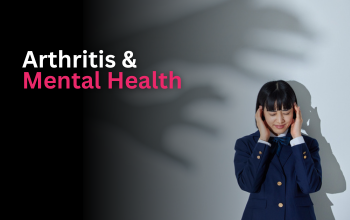The Arthritis Newsletter
Winter 2014Osteoarthritis - A Daily Companion
By Wendy Lum
In which the author reflects on the changes in her life brought about by a diagnosis of osteoarthritis
 Living with a chronic disease like arthritis has its cycles of ups and downs. Being a fitness enthusiast since the Jane Fonda workout days of the 70’s, I was a regular at the gym participating in a variety of fitness classes ranging from high and low impact aerobics, step classes, stationary bike interval training, weight lifting, dance classes, Pilates, regular and Bikram’s yoga. I got great value out of my gym memberships and I enjoyed physical exercise whether it was indoors at the gym or getting outdoors riding my bike, going for hikes or long walks along the dykes. Leading an active lifestyle was also one of my ways of dealing with stress.
Living with a chronic disease like arthritis has its cycles of ups and downs. Being a fitness enthusiast since the Jane Fonda workout days of the 70’s, I was a regular at the gym participating in a variety of fitness classes ranging from high and low impact aerobics, step classes, stationary bike interval training, weight lifting, dance classes, Pilates, regular and Bikram’s yoga. I got great value out of my gym memberships and I enjoyed physical exercise whether it was indoors at the gym or getting outdoors riding my bike, going for hikes or long walks along the dykes. Leading an active lifestyle was also one of my ways of dealing with stress.
I was diagnosed with osteoarthritis in my spine and hips a little over five years ago. My symptoms started slowly. In the beginning, I noticed reduced flexibility as I was doing my cool down floor exercises and as I was having difficulty tying my shoelaces. My doctor sent me for x-rays and it was confirmed that I had osteoarthritis and I was referred to OASIS (Osteoarthritis Service Integration System).
Osteoarthritis is the most common type of arthritis and it is a chronic degenerative disease that affects the joints of the body causing inflammation, stiffness and pain. There is no cure. It occurs when there is inflammation in the joint and the cartilage begins to wear away. A joint is where two bones meet and cartilage is the protective layer that covers the end of the bones and allows the bones to move smoothly over each other. When cartilage loss occurs, the joint can deteriorate to the point of rubbing bone against bone. The joints most commonly affected are the hips, knees, spine, hands and feet.
My journey with osteoarthritis is a process that I live with daily. I have difficulty sitting for long periods, bending and picking things from the floor and humid or damp cold weather affects my joints making them very stiff. As I have not made the decision to have hip replacement surgery, I have learned ways to cope at home and at work.
Here are some coping strategies for home:
- plan ahead what you are going to do
- alternate between light and heavy duties
- take breaks so you do not get stiff, sore or fatigued
- use assistive devices such as a long-handled reacher, shoehorn, dustpan or bathtub scrubber or cane
- use raised cushions for sitting to avoid low chairs and seats
- use a raised toilet seat
- minimize use of stairs and use handrails
- support feet by using a small stool when sitting
- use a wheeled dolly for carrying things and a buggy for grocery shopping
- use a sock aid and elastic shoelaces for dressing
- use pull-out shelves to minimize bending and store frequently used items between hip and shoulder height
- use stronger muscle groups of legs rather than weaker arm muscles when vacuuming
- use a firm mattress for sleeping
- sit while ironing, gardening and preparing meals
- wear supportive shoes
- use proper body mechanics
- journal and track changes in your arthritis symptoms
- rest
- use of heat or cold to help reduce pain and stiffness
- use of non-prescription medications such as acetaminophen, ibuprofen, acetylsalicylic acid and topical medications for pain relief and stiffness as per your medical health professional
The following are some coping strategies for work:
- assess your work situation with respect to making changes to how your work can be performed
- pace yourself and take breaks
- avoid sitting and standing for long periods
- evaluate work options such as working from home, flex-time, part-time, later start time, changed job duties
- avoid repetitive motions
- ask for assistance from employer and co-workers
- use an ergonomic work station
- use proper body mechanics
- wear supportive shoes
- use splints
Osteoarthritis has its challenges but one needs to remain positive and hopeful. I truly believe in the mind/body connection when it comes to healing, having gone through the stages of grief, loss and acceptance with my diagnosis. Adhere to the advice of your professional health care team (i.e. family doctor, rheumatologist, pharmacist, physical therapist, occupational therapist, registered massage therapist, etc. as well as reputable alternative therapists) and educate yourself about arthritis.
There are many reliable support agencies such as the Arthritis Research Centre of Canada and the Mary Pack Arthritis Centre that provide comprehensive information on arthritis. Replace old activities with new ones that protect your joints. For example; I have substituted stretching and pool exercises for the impactful activities I did in the past.
Other activities which are known to be beneficial for osteoarthritis patients are Tai Chi, yoga, Nordic Pole walking and Feldenkrais movement exercises. Reduce any excess weight by eating a balanced diet of whole foods to take the load off your joints. Practice mindfulness, deep breathing, meditation and relaxation exercises in combatting stress, anxiety and depression. If you believe in prayer and have a religious or spiritual foundation, tap into that to find the gratitude and joy in life. Enjoy time spent with family and friends – value the important things.




















































